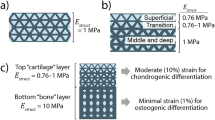Abstract
Cartilage repair is substantially intractable due to poor self-healing ability. Porous microspheres can be a fascinating three-dimensional matrix for cell culture and injectable carrier in cartilage engineering. In this study, we assessed the feasible use of porous biopolymer microspheres for chondrocyte carriers. When seeded onto the blended biopolymer microspheres and followed by a dynamic spinner flask culture, the chondrocytes showed robust growth behaviors during the culture period. The gene expressions of SOX9, type II collagen, and aggrecan were significantly upregulated after 2-week of culture. Furthermore, immunolocalization of type II collagen and secretion of glycosaminolglycan became prominent. The results suggest the feasible usefulness of the porous microspheres as the cell culture matrix and the subsequent delivery into cartilage defects.
Similar content being viewed by others
References
Hunziker EB. Articular cartilage repair: basic science and clinical progress. A review of the current status and prospects. Osteoarthritis Cartilage 2002;10:432–463.
Langer R, Vacanti JP. Tissue engineering. Science 1993;260:920–926.
Vinatier C, Bouffi C, Merceron C, Gordeladze J, Brondello JM, Jorgensen C, et al. Cartilage tissue engineering: towards a biomaterial-assisted mesenchymal stem cell therapy. Curr Stem Cell Res Ther 2009;4:318–329.
Ruuskanen MM, Virtanen MK, Tuominen H, Törmälä P, Waris T. Generation of cartilage from auricular and rib free perichondrial grafts around a self-reinforced polyglycolic acid mould in rabbits. Scand J Plast Reconstr Surg Hand Surg 1994;28:81–86.
Chen J, Wang C, Lü S, Wu J, Guo X, Duan C, et al. In vivo chondrogenesis of adult bone-marrow-derived autologous mesenchymal stem cells. Cell Tissue Res 2005;319:429–438.
Diduch DR, Jordan LC, Mierisch CM, Balian G. Marrow stromal cells embedded in alginate for repair of osteochondral defects. Arthroscopy 2000;16:571–577.
Tognana E, Borrione A, De Luca C, Pavesio A. Hyalograft C: hyaluronan-based scaffolds in tissue-engineered cartilage. Cells Tissues Organs 2007;186:97–103.
Awad HA, Wickham MQ, Leddy HA, Gimble JM, Guilak F. Chondrogenic differentiation of adipose-derived adult stem cells in agarose, alginate, and gelatin scaffolds. Biomaterials 2004;25:3211–3222.
Wang W, Li B, Li Y, Jiang Y, Ouyang H, Gao C. In vivo restoration of full-thickness cartilage defects by poly(lactide-co-glycolide) sponges filled with fibrin gel, bone marrow mesenchymal stem cells and DNA complexes. Biomaterials 2010;31:5953–5965.
Malda J, Woodfield TB, van der Vloodt F, Wilson C, Martens DE, Tramper J, et al. The effect of PEGT/PBT scaffold architecture on the composition of tissue engineered cartilage. Biomaterials 2005;26:63–72.
Mercier NR, Costantino HR, Tracy MA, Bonassar LJ. A novel injectable approach for cartilage formation in vivo using PLG microspheres. Ann Biomed Eng 2004;32:418–429.
Frondoza C, Sohrabi A, Hungerford D. Human chondrocytes proliferate and produce matrix components in microcarrier suspension culture. Biomaterials 1996;17:879–888.
Jin GZ, Park JH, Seo SJ, Kim HW. Dynamic cell culture on porous biopolymer microcarriers in a spinner flask for bone tissue engineering: a feasibility study. Biotechnol Lett 2014;36:1539–1548.
Oh SA, Lee HY, Lee JH, Kim TH, Jang JH, Kim HW, et al. Collagen three-dimensional hydrogel matrix carrying basic fibroblast growth factor for the cultivation of mesenchymal stem cells and osteogenic differentiation. Tissue Eng Part A 2012;18:1087–1100.
Lee HH, Hong SJ, Kim CH, Kim EC, Jang JH, Shin HI, et al. Preparation of hydroxyapatite spheres with an internal cavity as a scaffold for hard tissue regeneration. J Mater Sci Mater Med 2008;19:3029–3034.
Park JH, Lee EJ, Knowles JC, Kim HW. Preparation of in situ hardening composite microcarriers: calcium phosphate cement combined with alginate for bone regeneration. J Biomater Appl 2014;28:1079–1084.
Kang SW, Jeon O, Kim BS. Poly(lactic-co-glycolic acid) microspheres as an injectable scaffold for cartilage tissue engineering. Tissue Eng 2005;11: 438–447.
Author information
Authors and Affiliations
Corresponding author
Rights and permissions
About this article
Cite this article
Jin, GZ., Kim, HW. Porous microcarrier-enabled three-dimensional culture of chondrocytes for cartilage engineering: A feasibility study. Tissue Eng Regen Med 13, 235–241 (2016). https://doi.org/10.1007/s13770-016-0038-6
Received:
Revised:
Accepted:
Published:
Issue Date:
DOI: https://doi.org/10.1007/s13770-016-0038-6




